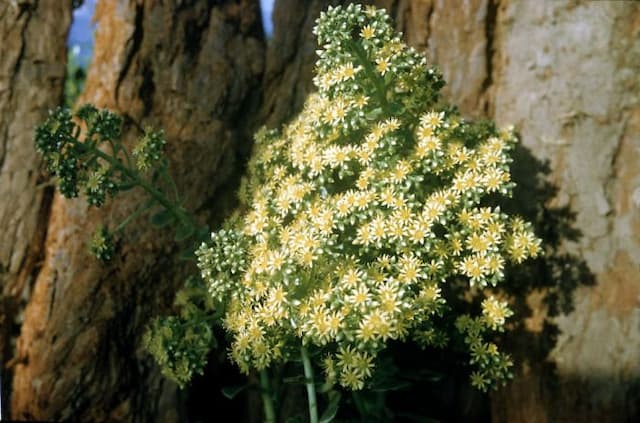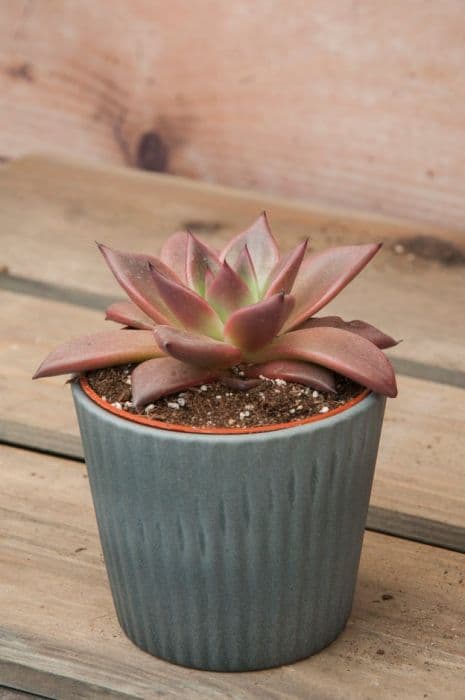Poldark Aeonium Aeonium 'Poldark'

ABOUT
Aeonium 'Poldark' is a striking and ornamental succulent known for its rosettes of leaves that can show off dramatic coloration. The rosettes are composed of densely packed, fleshy leaves that often exhibit a deep burgundy or near-black hue, especially towards the edges. This rich coloring can sometimes cover the entire leaf, though it's more typical to see a gradient effect with the deepest colors at the tips, transitioning to a green or slightly lighter shade near the center of the rosette. The leaves themselves are spoon-shaped with slightly pointed tips and have a glossy, smooth texture that can catch the light and appear almost shiny. They emanate from a central point, creating a symmetrical whirl that is aesthetically pleasing and geometrically interesting. During certain times of the year, Aeonium 'Poldark' may produce pyramidal or conical clusters of small star-shaped flowers. These blossoms are usually a lighter color, often a contrast to the dark foliage, which can create an eye-catching display. The plant is versatile and can make a robust impression on its own, or when planted with other succulents that highlight its unique coloring and structure. Its enticing appeal often comes from the deep, saturated colors of its foliage, which can add a touch of drama to any succulent collection or garden setting.
About this plant
 Names
NamesSynonyms
Tree Houseleek, Irish Rose.
Common names
Aeonium 'Poldark'.
 Toxicity
ToxicityTo humans
Aeonium 'Poldark', commonly known as Aeonium, is not known to be highly toxic to humans. However, like many plants, it could potentially cause mild irritation if ingested, such as an upset stomach. In general, it is always advisable to avoid ingesting parts of decorative plants due to potential individual sensitivities and the possibility of stomach discomfort or allergic reactions.
To pets
Aeonium 'Poldark', commonly referred to as Aeonium, is generally considered to be non-toxic to pets, including cats and dogs. While it is unlikely to cause severe poisoning, ingestion can sometimes result in vomiting or diarrhea due to the gastrointestinal irritation that can occur when pets chew on or ingest plant material that is not a part of their typical diet. It is always prudent to monitor pets and prevent them from eating plants, as individual reactions can vary.
 Characteristics
CharacteristicsLife cycle
Perennials
Foliage type
Evergreen
Color of leaves
Mixed
Height
2 feet (60 cm)
Spread
2 feet (60 cm)
Plant type
Succulent
Hardiness zones
9
Native area
Canary Islands
Benefits
 General Benefits
General Benefits- Decorative Appeal: Adds aesthetic value with its rosette-shaped foliage and deep burgundy color.
- Drought Tolerance: Aeonium 'Poldark' is succulent, requiring minimal water, making it suitable for xeriscaped gardens.
- Easy Care: It is a low-maintenance plant that does not need frequent watering or feeding, ideal for busy gardeners.
- Container Gardening: Suitable for growing in pots, allowing for easy movement and arrangement within the garden space.
- Pest Resistance: Generally resistant to pests, reducing the need for chemical pesticides.
 Medical Properties
Medical PropertiesThis plant is not used for medical purposes.
 Air-purifying Qualities
Air-purifying QualitiesThis plant is not specifically known for air purifying qualities.
 Other Uses
Other Uses- Photography and Art Subjects: The Aeonium 'Poldark' is often used by photographers and artists for its unique rosettes and deep coloring, making it a stunning subject for botanical artworks and photography projects.
- Bonsai-like Display: Although not a true bonsai species, Aeonium 'Poldark' can be grown in miniature form in small pots to mimic bonsai aesthetics for ornamental display.
- Craft and Jewelry: The rosettes of Aeonium 'Poldark' can be used in crafts and jewelry-making, particularly as natural adornments for eco-friendly pieces or botanical-themed accessories.
- Theme Gardens: This plant is ideal for creating thematic gardens such as Gothic or vampire-inspired landscapes due to its dark-coloured foliage.
- Educational Tool: Aeonium 'Poldark' can serve as an educational tool in horticulture and botany classes, demonstrating succulent care and propagation techniques.
- Wedding Decor: Its striking appearance makes it a popular choice for wedding bouquets, table centerpieces, and other decorations where a touch of unique natural beauty is desired.
- Culinary Presentation: Although not edible, the rosettes can be used as a natural garnish for plating and presenting dishes in high-end culinary settings.
- Feng Shui: Some people use Aeonium 'Poldark' in their homes as part of Feng Shui practices, believing it can bring positive energy and harmony when placed in the right area.
- Collectors' Item: This plant is popular among succulent collectors due to its distinct characteristics and is often sought after to complete a diverse succulent collection.
- Fantasy Gaming Scenery: Miniature versions of Aeonium 'Poldark' can be used to create realistic scenery in tabletop fantasy games and dioramas.
Interesting Facts
 Feng Shui
Feng ShuiThe Aeonium is not used in Feng Shui practice.
 Zodiac Sign Compitability
Zodiac Sign CompitabilityThe Aeonium is not used in astrology practice.
 Plant Symbolism
Plant Symbolism- Resilience: Aeoniums, including 'Poldark', have the ability to store water in their leaves, which symbolizes resilience and the ability to thrive under challenging circumstances.
- Perseverance: They are hardy plants that can survive in tough environments, often seen as a representation of one's ability to persist through difficulties.
- Uniqueness: The 'Poldark' variety, with its dark, burgundy-black foliage, signifies uniqueness and standing out from the crowd.
- Timelessness: As succulents, Aeonium 'Poldark' can live for many years, symbolizing endurance and timelessness.
- Transformation: This plant can change its appearance in response to varying light levels, exemplifying adaptability and personal growth.
- Beauty: With its rosette pattern and rich colors, the Aeonium 'Poldark' represents natural beauty and the aesthetics of nature.
 Water
WaterAeonium 'Poldark,' or 'Tree Houseleek,' requires watering every 7-10 days during the active growing season in spring and summer; however, in the cooler winter months, this frequency should be reduced to once a month as the plant enters a dormant phase. When watering, give enough to soak the soil thoroughly until water runs out of the pot's drainage holes, which might be around 8-16 ounces for smaller pots or up to 1-2 gallons for larger pots. Allow the soil to dry out completely between waterings to prevent root rot.
 Light
Light'Tree Houseleek' thrives in bright, indirect sunlight, and it's best positioned in a spot where it can receive at least six hours of sunlight each day without being exposed to the harsh afternoon sun. A south or west-facing window with some shading can provide ideal lighting conditions for healthy growth.
 Temperature
TemperatureThe ideal temperature range for 'Tree Houseleek' is between 65°F and 75°F, but it can survive in temperatures as low as 40°F and as high as 85°F. It's important to protect the plant from frost, which means keeping it above 40°F to prevent cold damage.
 Pruning
PruningPruning 'Tree Houseleek' is necessary to maintain its shape, remove any damaged or dead leaves, and encourage bushier growth. Light pruning can be done anytime during the year, but the best time is at the beginning of the growing season in spring. It's typically not required more than once or twice a year. Remove only the necessary foliage with sharp, clean shears to prevent any potential damage or disease.
 Cleaning
CleaningAs needed
 Soil
SoilThe ideal soil mix for Aeonium 'Poldark', commonly called Aeonium, should be well-draining with a combination of cactus potting mix and perlite or pumice at a ratio of 1:1. The recommended soil pH is slightly acidic to neutral, ranging from 6.0 to 7.0. This helps mimic their natural growing conditions and prevents root rot.
 Repotting
RepottingAeonium 'Poldark' should be repotted every two to three years, or when it's apparent that the plant has outgrown its current pot. The best time to repot is during the dormant period, which is typically in the summer for these succulents.
 Humidity & Misting
Humidity & MistingAeonium 'Poldark' prefers moderate humidity levels, as it is tolerant of a wide range of conditions but does not require the high humidity that some tropical plants do. Aim for a humidity level that is comfortable for typical indoor living conditions, avoiding excessively dry or damp air.
 Suitable locations
Suitable locationsIndoor
Place Aeonium in bright, indirect sunlight and rotate for even growth.
Outdoor
Plant Aeonium in partial shade and protect from extreme cold.
 Life cycle
Life cycleAeonium 'Poldark', commonly known as Poldark Aeonium, begins its life cycle as a seed, germinating in well-draining soil with ample warmth and light. After sprouting, it enters a vegetative stage, developing fleshy leaves in rosette formations characteristic of the Aeonium genus. As the plant matures, it undergoes a period of growth where it forms a stout stem and may produce offsets or "pups" around its base, allowing for vegetative propagation. Upon reaching maturity, Poldark Aeonium blooms, producing pyramidal inflorescences with numerous tiny, star-shaped flowers, usually in late winter or spring. After the blooming period, the flowering rosette typically dies, but the plant continues its lifecycle through the offsets which grow into new plants. The plant's life cycle is perennial, with individual rosettes having a lifespan of several years before the blooming event signals their end, while the offsets ensure the continuity of the species.
 Propogation
PropogationPropogation time
Spring-Early Summer
Aeonium 'Poldark', commonly known as Aeonium, is best propagated through stem cuttings during its active growth period in spring or early summer. To propagate using stem cuttings, a healthy stem is chosen and cut with a clean, sharp knife or pair of scissors. The cutting should be about 2 to 4 inches (approximately 5 to 10 centimeters) long, making sure it contains at least one rosette of leaves. After cutting, the stem is allowed to callous over for a few days to prevent rotting when planted. Once calloused, the stem is planted in well-draining soil, making sure that the end where the cut has been made is inserted into the soil. The soil should be kept slightly moist and the cutting should be placed in bright, indirect light until roots have developed, which typically takes several weeks.









